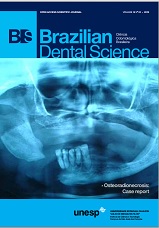Influence of photoinitiators and light sources on the degree of conversion of experimental resin cements.
DOI:
https://doi.org/10.14295/bds.2015.v18i2.1103Resumo
Objective: The aim of this study was to evaluate the degree of conversion (DC) of seven experimental resin cements formulated with different photoinitiators when activated by two light-curing units (LCUs) through ceramic material. Material and Methods: Seven resin blends with different camphorquinone (CQ) and/or phenyl propanedione (PPD) rates were prepared: C5: 0.5% wt CQ; C8: 0.8% wt CQ; P5: 0.5% wt PPD; P8: 0.8% wt PPD; C1P4: 0.1% wt CQ and 0.4% wt PPD; C4P1: 0.4% wt CQ and 0.1% wt PPD; and C4P4: 0.4% wt CQ and 0.4% wt PPD. Each mixture was loaded with 65% wt of silanized filler particles. For photoactivation procedures, two LCUs were used: a quartz-tungsten-halogen (QTH) and a light emitting diode (LED). Results: Irradiance (mW/cm²) was calculated by the ratio of the output power by the area of the tip. DC was assessed by Fourier transformed infrared spectroscopy. Data were submitted to a two-way ANOVA and Tukey’s test (5%). DC values do not show significant differences for LCUs regardless of the photoinitiator type. The highest DC was found for experimental cement P8 and the lowest for C5. Conclusion: Intermediate DC values were found for the other cements. However, when QTH was used, P8 exhibited differences among C1P4, C4P1 and C5; whereas when LED was employed, P8 differed only for C4P1 and C5. Thus, PPD is a viable alternative for the manufacture of photoactivated cements, and the PPD/CQ association may also be viable since C4P4 was similar to P8.
Downloads
Downloads
Publicado
Como Citar
Edição
Seção
Licença
TRANSFERÊNCIA DE DIREITOS AUTORAIS E DECLARAÇÃO DE RESPONSABILIDADE
Toda a propriedade de direitos autorais do artigo "____________________________________________________________________" é transferido do autor(es) para a CIÊNCIA ODONTOLÓGICA BRASILEIRA, no caso do trabalho ser publicado. O artigo não foi publicado em outro lugar e não foi submetido simultaneamente para publicação em outra revista.
Vimos por meio deste, atestar que trabalho é original e não apresenta dados manipulados, fraude ou plágio. Fizemos contribuição científica significativa para o estudo e estamos cientes dos dados apresentados e de acordo com a versão final do artigo. Assumimos total responsabilidade pelos aspectos éticos do estudo.
Este texto deve ser impresso e assinado por todos os autores. A versão digitalizada deverá ser apresentada como arquivo suplementar durante o processo de submissão.




























